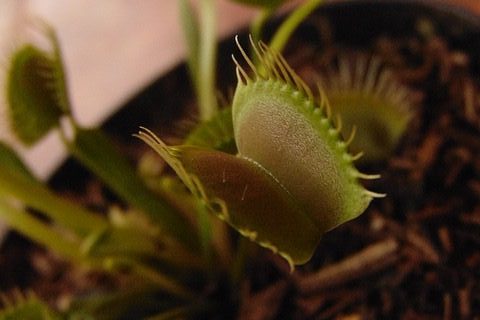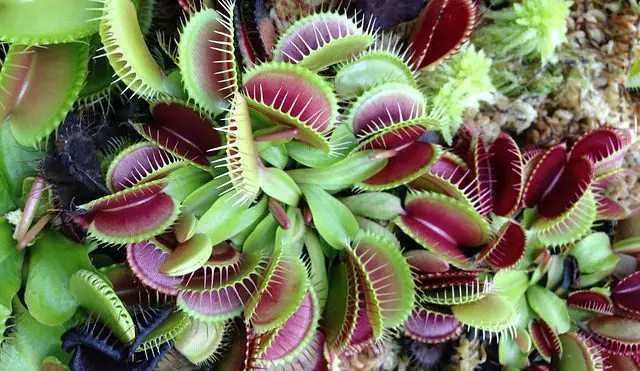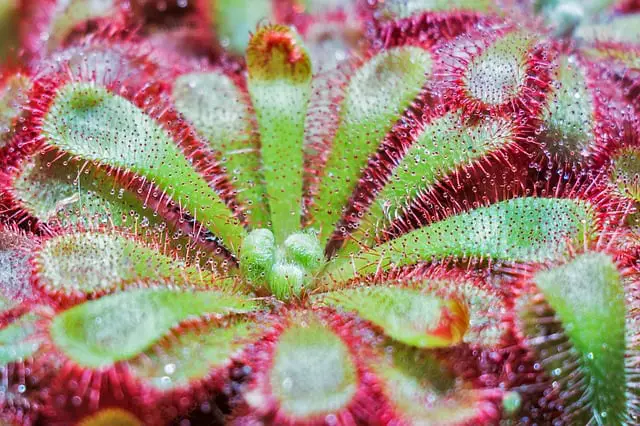One of the most curious thing about Venus flytraps it’s their trapping mechanism. Their traps snap to capture prey, and they reopen when they are ready for the next meal. As a Venus flytrap owner, the trapping mechanism struck my curiosity early on. After doing some research, I would like to share with you what I learned so far in this post.
Venus flytraps can close their traps in a fraction of a second. Trigger hairs inside the leaves send electrical signals to activate the trapping mechanisms. After snapping shut, the leaves can remain close 24 to 48 hours if the trap is empty or 7 to 20 days if it caught prey.
Now, let’s get into the details on how the trapping mechanism works to the core. Understanding the mechanism will help you perfect your feeding technique and preserve more leaves.
The Venus Flytrap Trapping Mechanism
Venus flytraps grow naturally in South Carolina and North Carolina. In their natural habitat, they receive plenty of light and water, but no nutrients from the soil. As a result of the inferior ground, Venus flytraps have evolved to be successful predators.
The leaves in Venus flytraps have evolved to look like jaw-like structures. Each trap is made up of two lobes. And, the border of each lobe has cilia that intertwine when it closes.
At its resting position, Venus flytraps remain open. The trap snaps shut only when it is triggered by an object or hopefully a being inside the leaves.
The plants effectiveness as a predator varies and is affected by several factors, such as the plant’s size, the prey dimensions and position of the victim.
How and When Venus Flytraps Close

In each lobe Venus flytraps have three trigger hairs. As shown in the picture on the left. The trigger hairs are very thin and they are arranged in a triangular pattern.
The trap closes when something has had contact with the trigger hairs twice within 20 seconds. Traps never close by a single stimulus, a second stimulus is required. The double stimuli mechanism reduces the chances of the trap closing due to an inanimate object.
With the double stimuli mechanism, the plant avoids closing due to stimuli coming from a falling twig, rain, or dust.
Venus flytraps spend large amounts of energy controlling the traps. The plant must ensure it is closing due to the presence of a potential victim. Still, sometimes, the double stimuli strategy fails. The trap or plant won’t die due to the mistake, but the plant will have less energy to grow.
Here is a summary of the Venus Flytrap closing mechanism:
- The trigger hairs receive stimulus twice within 20 seconds
- The trap snaps and closes almost completely (tiny insects might escape)
- The trap snaps shut if it detects continuous movement
- The trap remains close while digesting the prey
It is hypothesized that Venus flytraps test the size of the prey before they spend energy to consume it. The trap doesn’t close in a single stage. First, the lobes go into a semi-close stage. During that time, small insects can scape. Then, during the second stage, the trap closes shut and start the digestion process.
The Venus flytrap digestion process can take several days or even a few weeks, depending on the size of the insect. The trap will remain close shut during the whole process. When the hatch is closed, it fills with enzymes that slowly decompose the victim. Also, they prevent the entrance of bacteria or fungus.
Interesting Fact: The Traps Are Lightning fast
The traps of a Venus flytrap can snap shut very fast. They exhibit one of the fastest movements within the plant kingdom. The lobes can close in less than a second. Scientists explain the speed of the closing mechanism by transitioning from a convex position to a concave position. In simple terms, a Venus flytrap leaf works as a pop-up rubber cap. Overall, the motion is very fast as it has to be to capture the prey.
“Among carnivorous plants, the Venus flytrap is of particular interest for the rapid movement of its snap-traps and hypothesized prey selection, where small prey are allowed to escape from the traps (…) ” Understanding the Venus flytrap through mathematical modeling, Sami Lehtinen
Sometimes Venus fly traps won’t close their leaves to capture insects because they might be hibernating or sick. In this article, you can find more info on this: Why Venus Fly Traps Won’t Close Plus Easy Fixes.
What Can Trigger Venus Fly Traps
A variety of things can trigger the traps, for example:
- Humans
- Insects
- Arachnids
- Small frogs or lizards
- Small rodents, such as mice
- Inanimate objects, such as dust, air, rain, debris, twig
Even though many small animals can trigger the traps of a Venus flytrap, their diet consists almost exclusively on insects and arachnids. Technically, Venus flytrap can consume meat; however, their small traps are designed to capture small arthropods.
How Venus Flytraps Lure Prey
Venus flytraps lure prey with two elements: a bright color and sweet nectar. The plant secretes nectar on the inside surface of their traps. The nectar is sweet, and it emits an enticing scent. Also, the interior of the trap exhibits bright red color shades.
Potential victims get lured by the bright color, the nectar scent, or both factors. In many cases, the prey gets confused and believes it has just landed in a flower.
Once a bug lands inside a trap it will start consuming the nectar. Meanwhile, the Venus flytrap is waiting patiently for stimuli.
How and When Do Venus Flytraps Open?
Once a trap is closed shut, the trap will open in a few days if it is empty or 10-14 days if it is digesting a bug.
False alarm
Sometimes the double stimuli mechanism fails and the trap closes while empty inside. Also, sometimes humans activate the trigger hairs out of curiosity. In this scenario, the traps might reopen immediately or it might take a few days.
In some cases, the plant notices the lack of stimuli after closing and it reopens after a few minutes. Also, it might remain in a half-open half-close position for some hours.
In other cases, external stimuli can trick the plant into closing and believing it has capture prey. In those cases, the Venus flytrap will reopen but might take 24-72 hours to do so.
After a good meal
Venus flytraps reopen when they have finished consuming their prey. The plant can consume most parts of the insects except for the skeleton. When the trap reopens, it leaves the dry skeleton behind.
The opening or reopening motion of Venus flytraps is not fast (like the closing). They open up slowly, as there is no need for speed in this case.
When they finally open, the trap is ready to capture another prey immediately.
What Happens to the Leaves After Closing/Opening?
The Venus flytrap is always changing leaves. The traps can close a handful of times before they wither and die (the exact number varies depending on the plant and the leaf). Once a trap has closed the maximum of times, then it will start turning dark and finally, it will dry up.
This process is completely normal. Leaves die all the time and new ones star spurring from the bulb. New Venus flytrap growers sometimes freak out when they see leaves turning black. They think it is a clear sign of a dying Venus flytrap. But, the leaf cycle is a normal process.
In the picture below, you can observe a healthy Venus flytrap exhibiting some vibrant colors. Also, you might notice some black leaves on the side of the plant. Those are the old traps that are slowly drying up and decomposing. Growers should only worry if leaves start dying, but there is no replacement growing.
Also, the black leaves won’t spread through the rest of the plant. It is not an infection, but simply traps completing their cycle.

Sometimes Venus flytraps capture large prey. In those cases, the trap will attempt to consume the bug, but it might be unsuccessful. If the victim is too big for the leaf, the plant abandons the cause and lets the whole leaf die.
Obviously, this scenario is not optimal. The plant is able to absorb some nutrients but ultimately loses a trap unexpectedly due to the size of the prey.
Why Do Venus Flytrap Need a Trapping Mechanism?
The Venus flytrap developed a trapping mechanism to capture bugs and supplement their diet. But, bugs are not an essential part of their diet.
Venus flytraps do not need bugs to survive, they produce their own food through photosynthesis (like other plants). The bugs they consume are an extra boost. Venus flytraps do not have access to key nutritious elements in the soil, but they can contain those same elements from prey.
Venus flytraps do not rely on the trapping mechanism to survive. However, it can be very useful to capture prey as the plant has a lot more energy to use of growing and developing.
Regardless of the status of a trap either when it is open, close, or is starting to die, it contributes to the photosynthesis process.
Related Recommendations for Venus Flytrap Owners
Follow the considerations below to keep Venus flytrap leaves healthy and let the trapping mechanisms function properly:
- Do not attempt to open a leaf forcefully. Instead, let the leaf follow a normal behavior. The strain on the trap can reduce its life span.
- Sometimes traps trigger due to inanimate objects or external stimuli. Do not worry if a trap is closed without a bug inside.
- Venus flytraps will only close shut if they receive stimuli from a live bug. Still, you can feed your plant dead bugs. However, you might have to follow some additional instructions to be successful. Here is a guide for that purpose.
- Do not remove dying leaves before they have withered completely. They should completely blacken and dry out.
- Avoid triggering the traps of your plant. Save your plant’s energy by letting your plant focus on capturing prey.
- When you buy Venus flytraps from a store or online, traps might be close due to shipping or excessive contact due to transportation. This is normal. Still, it would help if you were very careful with your plant to let it set in its new home.
- Keep your venus flytrap diet simple. You can trigger your plant’s trap with different types of feed, but you should stick to bugs and spiders. Do not attempt to feed your plant with human food. Harburger, candy, chicken, or anything similar can damage your plant.
Trapping Mechanism And Types of Carnivorous Plants
Each carnivorous plant exhibits a very particular trapping mechanism. All those mechanisms can be observed in nature and clarify into different types. Here are a few examples.
Adhesive traps: Some carnivorous plants characterize with sticky leaves. The leaves secrete an adhesive substance. When a bug comes in contact with the leaf, it gets stuck. Sundews and butterworts are some good examples of adhesive trap carnivorous plants.

Pitfall traps: Pitcher plants, for example, characterize with pitcher-like leaf structures. When a victim falls within the pitcher it encounters a slippery surface filled with enzymes.
Suction traps: Bladderworts exhibit suction trap mechanisms. They have highly modified leaves in the shape of a bladder with a hinged door lined with trigger hairs.
Snap traps: The Venus flytrap is not the only snap trap carnivorous plant. The waterwheel plant has hinged leaves. These snap shut in response to stimuli from trigger hairs (similarly to Venus flytraps).
Related Questions
How many times can a Venus flytrap close before it dies?
Venus flytraps do not die when they close. Each trap has a set useful life. After that period has been fulfilled, then the leaf withers. Each trap is usually able to open and close five times before it dies.
Do Venus flytraps die when you touch them?
Venus flytraps do not die when you touch them. However, when you trigger the traps and make them close, you are wasting the plant’s energy. This won’t lead to deaf directly but will weaken the plant. If you are interested in activating the traps, consider feeding your plant to observe the mechanism.
Why do Venus flytraps not close?
A Venus flytrap leaf might not close because the leaf is dying or because the plant is adapting to a new environment. Once a trap is about to start withering, it stops being capable of snapping. Also, during extreme winters, summer, or maybe a change in environment, your Venus flytrap might be undergoing some changes and focusing on photosynthesis rather than capturing bugs.
Can a bug escape from a Venus flytrap after the trap is closed?
A trapped insect can escape from inside a trap if it is strong enough or if it can eat its way out (slugs for example). But, the victim will have to escape quickly before the plant kills them. When the trap is closed shut, the plant starts producing enzymes.
Glands secrete enzymes inside the trap and cause the victim to drown. Then, the enzymes start digesting the victim immediately, but slowly. The process can take a couple of weeks.
I have heard of slugs or caterpillars eating the traps from the inside to prevent their death. Main takeaway: avoid feeding your Venus flytrap leaf-eating insects.

